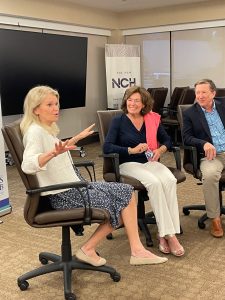
Martha Raddatz, Natalie Jacobson, Bob Orr
Legendary Boston news anchor Natalie Jacobson, who spent 35 years leading top-rated WCVB-TV, shared stories about her journalism journey in a lunch meeting of the Press Club of Southwest Florida at the NCH North Naples Hospital Board Room on Wednesday, April 10.
Jacobson was briefly joined by a former WCVB colleague, Martha Raddatz, who is the Chief Global Affairs Correspondent for ABC News. Raddatz, who had been trying to reconnect with Jacobson for years, was on assignment in Naples and took the opportunity to participate in the conversation facilitated by Press Club Vice President Bob Orr, a retired CBS News Correspondent.
Jacobson is best known for her insightful reporting and for breaking through in a male-dominated industry to become the first female anchor of a Boston evening newscast.
At first, she said, “I couldn’t get a job at any stations. Then I put together a portfolio. That helped me get hired, but I had to wait for a couple of years to become a reporter.”
Initially Jacobson was hired to do community needs research, a requirement for a federal communications license. She loved meeting with people throughout Boston, from the guy doing the construction work in the streets, to elected officials, including the mayor. Jacobson spent two years getting to know Boston and what its people wanted to see on their news program. Those experiences sharpened the skills that would help her become a top-flight journalist.
Raddatz, widely respected for her in-depth coverage of foreign affairs and security, worked with Jacobson for 12 years. Both remembered WCVB as a “family” and said the news team focused on connecting with their viewers. Raddatz credited Jacobson with always pushing the station to do more. For Jacobson, that usually meant asking another question. “You absolutely need to be curious to be a good reporter.” Jacobson added that TV stations, and media in general, always need to answer the questions: “What is our mission? Why do we do what we do?”
Raddatz lamented that journalists today face some increased pressures. “News programs used to be an hour long and we would have eight or nine minutes for an in-depth story,” she said. “Now, we’re fortunate to get 45 seconds. It’s like those college term papers you had to write. It is easier to write something long than something short, concise, and impactful.”
New England viewers fondly remember Jacobson as half of the famous “Nat and Chet” team, a reference to Natalie’s 17-year run co-anchoring the 6 p.m. and 11 p.m. newscasts with her husband, Chet Curtis.
Orr asked her, “How do you spend that many years as an anchor team and stay married? So many hours on the job!”
Jacobson laughed and shared a story about the Queen of England’s visit in 1976 to celebrate the U.S. Bicentennial. She and Curtis were on the air from 8 a.m. to 5 p.m. LIVE! He did the play-by-play. She did the color, because, of course, she had been doing all the research in advance of the Queen’s visit. “It worked for us,” she said.
But Jacobson agreed it’s a more challenging media landscape today. Orr asked, “The speed of things today is coming out 24/7. How do you decide what to broadcast?”
Jacobson replied: “You follow the script. You can’t possibly have time to report on everything every day. Now we’re doing news all day: early morning, noon, afternoon, evening, late evening.”
She mentioned that in the ‘80s cable news started, originally on CNN. “It was fabulous! Then, more personalities became involved. The more outrageous news stories you could get were aired. Then came the internet—people can say anything that they want to say. Now, what do we have?”
Orr said, “There are no firewalls anymore. Information and misinformation co-exist. We have to provide people with a reason to watch TV news. Some coverage isn’t worth the time. There is dumbing down. We need to take it down to the primary source. But, unless someone pays for ads, we’re out of business.”
Jacobson replied, “In the late ‘80s we did a pretty good job. Why do we think the way we do now? How do we raise our children? And, the bigger network corporations are buying up the smaller ones.”
Questions. It seems with Natalie Jacobson, there are always more questions. And the need to push for answers.
Jacobson is the author of her memoir, “Every Life A Story: Natalie Jacobson Reporting,” which was published in 2022.

